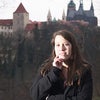This Place is the name of an International exhibition currently shown in the DOX gallery in Prague. The DOX Center for Contemporary Art, Architecture and Design has been organizing and hosting exhibitions for six years now. It has presented over 120 exhibition projects and is ranked among the most progressive artistic institutions in the Czech Republic.
The exhibition shows the photographs of twelve artists, each with a unique angle of the Israel-Palestine conflict. The exhibition of over 500 photos opened on October 24th and will be on display until March 2nd 2015. After Prague the exhibition will move to Tel Aviv for six months. After that it will be exhibited in the Norton Museum of Art followed by the Brooklyn Museum of Art. The exhibition will officially end on June 5th 2016. There are also thirteen original books produced for the exhibition - one with photos of each individual photographer and one comprehensive catalog. On Saturday October 25th, I saw four of the artists talk about their experience of creating This Place.
"I can't call it Israel," says photographer Gilles Peress while referring to flying to the location, "I call it Israelstein. It's a combination of the two." Peress's photos are very clear; they show the different perspectives of one community. He remarked that in Israel and Palestine everything happens meter by meter, room to room. "You see stores disappearing one by one, I return to the same place again and again," Peress explains his process of watching the changes. His pieces in this exhibition try to explore the reason why people don't see the similarities between each other - "Desperate lives," he sighs, "looking for differences."
The content of Wendy Ewald's project differed greatly from those of her colleagues. She explored what different communities in the area considered most important. Ewald had a total of fourteen different mini-projects exploring the lives of groups that ranged from women attending an orthodox military school to elderly villagers. She taught them seminars on photography and observed "how education forms the country." Ewald taught these groups of people to take photos of what impacted their lives and taught them to use metaphors. Then she compared what different groups concentrated on in their photography.
Fazal Sheikh, like all the other photographers, had issues with photographing in the region. "I prefer an open perspective," said Sheikh, "Israel is extremely constricting." His project was about the transformation of the land. He visited a village that is now unrecognizable. It was transformed into a forest and the people who once lived there became displaced around the country. He decided to fly over the desert after spending time in a protest tent overlooking the dry barren land that would become a dense forest. He coupled taking photographs from a helicopter with listening to stories from combatants on both sides.
Joseph Koudelka, a Czech photographer, talked about originally denying Frederic Brenner's invitation to cooperate with this project. "I bought my own ticket," said Koudelka, "to avoid having any obligation." He was born in 1938 and experienced the German occupation of his village. Later he witnessed the Russians first liberating the Czechs and then occupying them. "I grew up behind the Iron Curtain and always wanted to see the other side," Koudelka expressed his sympathy for the people in the area. His book doesn't always show the people, but you can see the impact of mankind in every photograph.
The subject of the title came up in the discussion. All the books and the project itself avoid naming the area that has had so many in its past. Art can be a tool of propaganda and the Israel-Palestine topic is a sensitive one with extremists on both sides. A name that didn't lean to either side of the conflict seemed the most appropriate and most objective to allow the viewers to interpret the meaning.
More information can be found on their website: http://www.dox.cz/cs/vystavy/this-place
